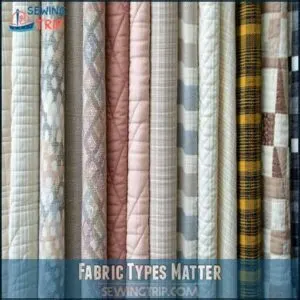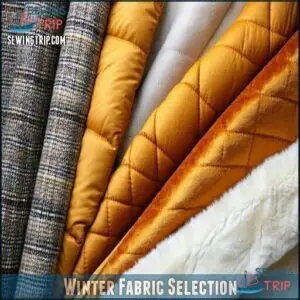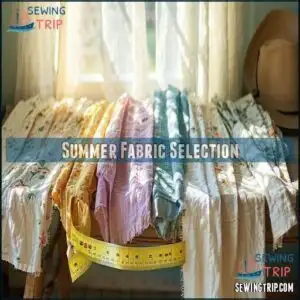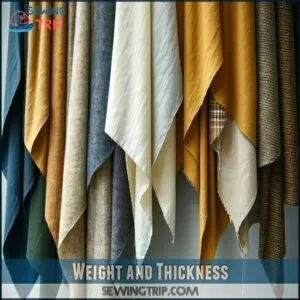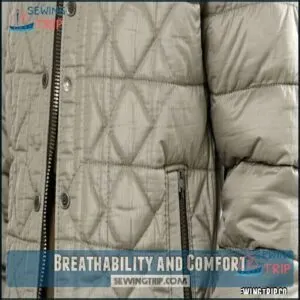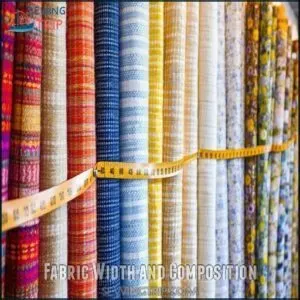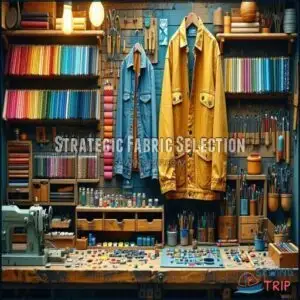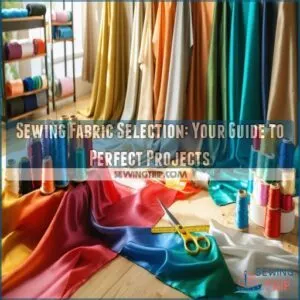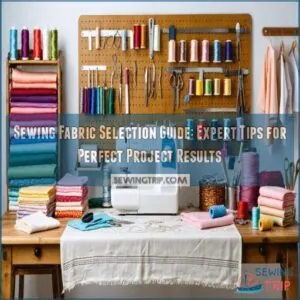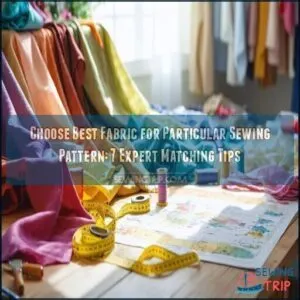This site is supported by our readers. We may earn a commission, at no cost to you, if you purchase through links.
 Choosing the right fabric for quilted jackets is like picking teammates for a group project—you want options that are strong, reliable, and up for the challenge.
Choosing the right fabric for quilted jackets is like picking teammates for a group project—you want options that are strong, reliable, and up for the challenge.
Cotton is breathable and soft, but it works best for casual jackets. For water resistance, lightweight nylon or polyester are stars, while wool blends crank up the coziness.
Pre-quilted fabrics save time, but stitching your own lets you get creative. Pay attention to weight and thickness for insulation, plus breathability for comfort.
And don’t forget care instructions—nobody loves surprise shrinkage! Select fabrics that match the season and mood, and you’ll wear your masterpiece with pride!
Table Of Contents
Key Takeaways
- Choose fabrics like cotton blends or synthetics for durability, breathability, and comfort based on your jacket’s purpose and the season.
- Lightweight batting, like cotton or wool, adds warmth without bulk, making it perfect for layering in a quilted jacket.
- Pre-quilted and reversible fabrics save time and give you flexibility, letting you create stylish and practical designs with ease.
- Avoid surprises by checking fabric care instructions, including washing, drying, and shrinkage, to keep your jacket looking its best.
Fabric Types Matter
Choosing the right fabric for your quilted jacket isn’t just about looks—it’s what makes your jacket cozy, breathable, and long-lasting.
The fabric you choose defines your quilted jacket’s comfort, breathability, and durability—where style meets practicality in every stitch.
Whether you prefer the softness of cotton, the durability of synthetics, or the charm of heirloom quilts, your choice sets the tone for comfort and style.
Cotton and Linen Blends
Choosing cotton and linen blends for quilted jacket fabric is a smart move.
These natural fibers breathe well, keeping you comfy.
Blend ratios, like 60% cotton to 40% linen, balance softness and durability.
Weave types affect texture—closely woven options feel smoother.
Consider exploring a wide variety online for your project.
Opt for eco-friendly dyeing methods to highlight your jacket’s charm.
Perfect for breathable, stylish garment applications!
Synthetic Fabrics
Synthetic fabrics are great for quilted jackets. They’re lightweight, strong, and budget-friendly while offering high performance.
- Polyester Durability: Stays tough and resists wear.
- Acrylic Warmth: Adds snug coziness.
- Nylon Strength: Handles rough use.
- Microfiber Softness: Feels luxurious.
- Blends Performance: Combines the best of each material.
These options are perfect for innovative, durable jacket fabric choices! Consider exploring various synthetic jacket options available today.
Pre-Quilted Fabrics
Pre-quilted fabrics are a dream for sewing quilted jackets.
Double-sided fabrics offer reversible options, letting you switch up your look effortlessly. Cotton calico adds warmth, while jersey and sweatshirt materials deliver softness with a cozy vibe.
Prequilted fabric saves time, combining style and convenience. For best results, consider that quilting cotton’s tight weave enhances durability.
It’s a trendy choice for fashion enthusiasts craving effortless chic and practical fabric selection.
Family Heirloom Quilts
Including heirloom quilts in your quilted jackets is like stitching a story into every seam. With their Quilt History and Sentimental Value, they offer timeless charm.
Stitching heirloom quilts into your jacket weaves history and sentiment into timeless, wearable art full of charm and tradition.
Use these tips to incorporate heirloom quilts into your quilted jackets:
- Restore fabric with gentle Restoration Techniques.
- Pair with durable cotton quilting fabric for longevity.
- Choose a complementary lining fabric.
- Honor traditions with modern interpretations, reviving heirloom quilts stylishly, adding a touch of timeless charm.
Seasonal Fabric Choices
You’ve got to choose fabrics that work with the seasons, or you’ll end up too chilly or uncomfortably warm.
Focus on cozy, insulating options for winter and lighter, breathable materials for summer to keep things practical and stylish year-round.
Winter Fabric Selection
When temperatures drop, a warm jacket fabric is your best friend.
Wool fabrics, down jacket fabric, or quilted jacket lining provide excellent insulation properties and cold weather durability.
Layering fabrics with moisture resistance add function without sacrificing winter aesthetics.
Here’s how popular winter fabrics perform:
| Fabric Type | Insulation | Moisture Resistance | Durability | Style Rating |
|---|---|---|---|---|
| Wool | High | Moderate | High | Classic |
| Down | Very High | Low | Moderate | Luxe |
| Fleece | Medium | Low | High | Casual |
| Polyester | High | High | High | Versatile |
| Velvet | Moderate | Low | Moderate | Elegance |
Summer Fabric Selection
When choosing lightweight jacket fabric for summer, focus on breathable weaves like cotton or linen blends.
These materials keep you cool while adding charm to summer fashion. Look for vibrant colors or cooling linings for a fresh feel.
Plus, some fabrics offer sun protection—perfect for those warm, sunny outings! Linen offers excellent breathability and durability.
Stay comfy without skipping style.
Climate Considerations
Living in different regions means your quilted jacket must adapt! Think about local weather—humidity or snowstorms influence fabric choices.
For customized comfort and durability:
- Pick breathable jacket fabric for tropical climates.
- Use synthetic insulation fabric for winter fashion.
- Choose lightweight jacket fabric in mild areas.
- Opt for water-resistant fabrics for wet zones.
- Balance insulation needs with breathable fabrics.
Stay cozy, wherever you are!
Fabric Properties
When picking fabric for a quilted jacket, it’s important to understand how its weight, breathability, and care needs affect the final garment.
Don’t worry, it’s easier than it sounds—think of it as matching fabric to how you want your jacket to feel and perform.
Weight and Thickness
Fabric weight and thickness shape your quilted jacket’s personality.
Heavier batting density brings warmth for winter, while lightweight jacket fabric suits layering options.
Thicker materials add structure but can reduce drape quality.
Understanding grams per square meter helps determine the fabric’s suitability for different uses.
Picture fabric types below to refine your choice:
| Season | Weight | Drape | Warmth | Best Usage |
|---|---|---|---|---|
| Winter | Heavy | Stiff | High | Long Coats |
| Fall | Medium | Balanced | Moderate | Everyday Jackets |
| Spring | Light | Flexible | Low | Seasonal Layers |
| Formal Wear | Medium-Light | Flowing | Moderate-Low | Elegant Vests |
| Casual | Lightweight | Relaxed | Low | Sporty Outerwear |
Breathability and Comfort
Nothing beats the comfort of a breathable jacket fabric.
Natural fibers like cotton blends guarantee climate control and soft moisture-wicking layers that feel great on skin—especially for those with skin sensitivity.
Add a lightweight lining and batting for comfort without bulk.
Whether layering for warmth or style, prioritize fabrics that let your skin breathe, it’s stylish science that promotes a comfortable wear, considering the importance of breathable materials.
Wash and Care Instructions
Caring for quilted jackets isn’t rocket science, but it takes attention.
Always spot-clean stains first using a gentle method.
Use a cool wash cycle with the right detergent for your fabric composition.
For drying methods, tumble on low with tennis balls to fluff.
Avoid high heat and store loosely to protect fabric finishes and long-term quality.
Fabric Width and Composition
You’ll often find fabric widths for quilted jackets around 150 centimeters, a handy standard for most projects.
Fiber content, like cotton or nylon, influences comfort and durability. Match wadding composition to warmth needs.
Layering fabrics? Balance fabric blends for the perfect fit. Remember, polyester quilting fabric and nylon quilting fabric are durable picks for practical, stylish creations.
| Fabric Type | Typical Width | Key Feature |
|---|---|---|
| Cotton Blends | 150 cm | Breathable and versatile |
| Nylon Quilting Fabric | 150 cm | Lightweight, water-resistant |
| Polyester Fabrics | 150 cm | Durable yet cost-effective |
Choosing Quilting Fabric
Picking the right fabric for your quilted jacket isn’t just about looks—it’s about comfort and durability too.
With so many colors, textures, and prices to explore, you’re sure to find something that matches your style and keeps you cozy.
Pattern and Texture Options
Fabrics with intricate patterns and interesting textures can make your quilted jacket pop.
Geometric patterns add a modern edge, while floral designs feel timeless.
Abstract quilting brings unique character, perfect for bold statements. Many quilters find inspiration in complex pattern designs.
Focus on stitch density and fabric embossing, as they enhance texture and visual interest. The right fabric patterns for quilting create jackets with personality that’ll turn heads!
Color and Design Considerations
Choosing colors and designs for your quilted jacket is all about creating impact! Use color psychology to set the mood—warm hues like red energize, while blues soothe.
Play with print scale and color placement for balance. Fashion patterns can add intrigue, and embracing contrast levels boosts dimension.
Experiment with color theory and fashion pattern play to make your look unforgettable. For balanced vibrancy, consider using triadic color schemes to create a unique and unforgettable style.
Quilting Fabric Pricing
Quality meets affordability when considering jacket quilting materials.
Understanding fabric pricing can help balance value and style.
- Cotton Pricing: Starts around $8 per yard for solids.
- Jersey Costs: Averages $15–$17.
- Reversible Fabrics: Trendy but pricier, near $27.
- Denim Options: Roughly $18.
- Woven Prices: Durable, at $15 per yard.
Smart fabric selection pairs cost with quality.
Investing in Premium Fabrics
Luxury fibers and ethical sourcing often mean higher costs, but think of premium fabrics as investment pieces—worth every penny for their fabric longevity and standout style.
Designer collaborations bring unique textures and top-tier fabric quality, perfect for jacket quilting materials.
The best fabrics for quilting boast balanced fabric weight, ensuring comfort without bulk, and elevate your craftsmanship effortlessly, making them a valuable choice.
Strategic Fabric Selection
Choosing the right fabrics for your quilted jacket is like building a solid foundation—it sets the tone for comfort, style, and durability.
By planning ahead and keeping track of your options, you’ll create a piece that’s as practical as it’s beautiful.
Creating a Fabric Mood Board
Imagine piecing together your perfect quilted jacket like crafting a story.
A fabric mood board helps you sort fabric swatches, explore texture combinations, and try fresh color palettes.
Use mood board software or plain paper for visual storytelling, blending fabric inspiration and documentation.
Inspiration gathering turns creative chaos into direction, giving your fabric selection bold, personal flair, and making it a part of fabric inspiration.
Building a Fabric Swatch Library
A fabric swatch library is your personal treasure chest for fabric selection.
Gather small samples during fabric trials to touch, compare, and learn.
Swatch organization helps with quick fabric identification, while library curation lets you experiment with textures and patterns.
Tactile learning guarantees smarter choices, and resource sharing with friends might spark fresh fabric recommendations.
Documenting Fabric Choices
Keeping a fabric inventory simplifies quilted jacket planning.
Use digital catalogs to organize supplier information, track costs, and document your fabric selection.
Snap photos, jot details like weight or texture, and tag projects they suit.
Future you’ll thank you when choosing fabric becomes less a guessing game and more like piecing together a perfect sewing puzzle, making it a fun experience to find the right fabric for your sewing projects.
Continuing Education on Fabrics
Immerse yourself in fabric workshops to sharpen your knowledge on textile certifications, fiber science, and dyeing techniques.
Stay updated on sustainable sourcing and fabric quality to verify you’re using the best fabrics for quilting.
Exploring courses on fabric types and selection makes it easier to craft quilted jackets with style and comfort. Think of it as your creative edge!
Frequently Asked Questions (FAQs)
What fabric to use for a quilted jacket?
Think of your quilted jacket like a blank canvas—choose cotton blends for breathability, pre-quilted fabrics for ease, or synthetic options for durability.
Add a soft lining like rayon for that luxurious, snug finish.
What is the best batting for quilted jackets?
Go with lightweight cotton or wool batting for warmth without bulk.
It’s cozy, breathable, and easy to quilt.
Synthetic options work too if you want durability and less shrinkage—perfect for those everyday outdoor adventures!
What are the 4 kinds of fabric in quilting?
Did you know quilters stitch over 3 meters of fabric per second worldwide?
In quilting, you’ll find cotton, linen blends, synthetics, and pre-quilted fabrics—each offering unique textures, comfort, and versatility to spark creativity!
What fabrics are best for reversible garments?
You’ll want fabrics like pre-quilted cottons, reversible double-gauze, or soft jerseys for reversible garments.
They’re lightweight, cozy, and easy to sew, plus they make flipping sides a breeze.
Bonus: each side adds personality!
How does fabric drape affect quilted jackets?
Over 60% of fabric appeal lies in its drape.
A flexible drape creates natural movement in quilted jackets, balancing structure with softness.
Pick wisely—stiff fabrics can feel boxy, while overly soft ones may lack shape.
Are waterproof fabrics suitable for quilting?
Waterproof fabrics can work for quilting, especially for outdoor jackets.
Choose lightweight options like nylon or Gore-Tex for flexibility.
Just make certain seams are sealed properly to keep water out, and you’ll be adventure-ready!
What fabrics work well with intricate stitching?
Did you know skilled stitching can transform fabric?
Cotton blends shine for intricate quilting, offering smooth finishes.
Linen adds charm with its texture, while sturdy synthetics guarantee durability.
Choose carefully—you’re crafting more than clothing; it’s art!
Can light fabrics provide sufficient warmth in winter?
Light fabrics can work if you layer wisely.
Pair them with insulating batting or a cozy lining for extra warmth.
Think of it as building a sandwich—your outer layer protects, the filling keeps you toasty!
Conclusion
Picture yourself buttoning up a quilted jacket that feels just right—light yet warm, breathable yet sturdy.
That’s the power of smart fabric selection for quilted jackets. By choosing materials that suit the season, offer comfort, and match your style, you’ll create a garment that’s as practical as it’s personal.
Experiment with textures, colors, and pre-quilted or self-quilted styles. Remember, great jackets start with great fabrics, so trust your instincts and let creativity guide your choices.

